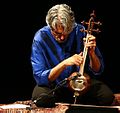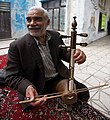Kamancheh
 Persian Kamānches, ca. 1880 | |
| String instrument | |
|---|---|
| Other names | Kamancha, Kamanche, Kemancheh, Kamanjah, Kabak kemane |
| Classification | Bowed strings |
| Developed | Iran |
| Playing range | |
| g3-e7 | |
| Related instruments | |
| Musicians | |
| |
| Builders | |
| |
| Sound sample | |
| Art of crafting and playing with Kamantcheh/Kamancha, a bowed string musical instrument | |
|---|---|
| Country | Azerbaijan and Iran |
| Reference | 01286 |
| Inscription history | |
| Inscription | 2017 (13th session) |
| List | Representative |

The kamancheh (also kamānche or kamāncha) (
Armenian,[3] Kurdish,[4] Georgian, Turkmen, and Uzbek music with slight variations in the structure of the instrument.[5][6] The kamancheh is related to the rebab which is the historical ancestor of the kamancheh and the bowed Byzantine lyra.[7] The strings are played with a variable-tension bow
.
In 2017, the art of crafting and playing with Kamantcheh/Kamancha was included into the UNESCO Intangible Cultural Heritage Lists of Azerbaijan and Iran.[8]
Name and etymology
The word "kamancheh" means "little bow" in Persian (kæman, bow, and -cheh, diminutive).Turkish music which is only slightly different from the Iranian kamancheh.[10]
Structure
The kamancheh has a long neck including
tuning pegs. The body has a long upper neck and a lower bowl-shaped resonating chamber made from a gourd or wood, usually covered with a membrane made from the skin of a lamb, goat or sometimes a fish, on which the bridge is set. From the bottom protrudes a spike to support the kamancheh while it is being played, hence in English, the instrument is sometimes called the spiked fiddle. It is played sitting down held like a cello though it is about the length of a viol. The end-pin can rest on the knee or thigh while the player is seated in a chair.[6]
Kamancheh is usually tuned like an ordinary violin (G, D, A, E).
-
Kamancha on the Armenian miniature, XVI or XVII century.
-
Qajar Iran miniature of a woman playing the kamancheh.
-
A woman playing the kamancheh. Detail from a wall painting in which Mohammad Ali Shah Qajar is surrounded by musicians and dancers. Painted by Abuʾl-Qasim, dated 1816.[12]
-
Woman playing kamancheh, ca. 1820.
-
The Armenian ashugh Sayat-Nova playing a kamanacheh, ca. 1964.
-
Azerbaijani kamancheh player Malik Mansurov.
-
Kayhan Kalhor performance in Vahdat Hall, Tehran, 2016.
-
Kamancheh player, Kermanshah, Iran, 2008.
-
Kamancha player, Yerevan.
Notable kamancheh players
- Habil Aliyev
- Mehdi Bagheri
- Ali-Asghar Bahari
- Mark Eliyahu
- Kayhan Kalhor
- Ardeshir Kamkar
- Kourosh Babaei
- Sayat-Nova
- Yaara Beeri
- Mehrnam Rastegari
See also
- List of bowed stringed instruments
- Music of Iran
- Music of Azerbaijan
- Byzantine lira
- Haegeum
- Rebab
- Silk Road Ensemble
References
- ISBN 9781135863685.
- ^ "Kamancha". UNESCO.
In the Republic of Azerbaijan it constitutes a major element of classical and folkloric music, and performances occupy a central place in a wide number of social and cultural gatherings.
- ISBN 90-6831-795-4.
- ^ "Iranian Kurdish musician wins prestigious award". Kurdistan24. 19 August 2019. Retrieved 24 March 2020.
- ^ "Pastimes of Central Asians. Musicians. A Man Practising the Kamancha, a Long-necked Stringed Instrument". World Digital Library. 1865. Retrieved 14 May 2014.
- ^ ISBN 9781610694995.
- ^ "Iranian string instrument 'Kamancheh' to be inscribed on UNESCO list". 11 April 2015. Retrieved 1 May 2015.
- ^ "Art of crafting and playing with Kamantcheh/Kamancha, a bowed string musical instrument". UNESCO.
- ^ "کمانچه – پارسی ویکی". loghatnaameh.com. Archived from the original on 2008-10-17.
- ^ "Kabak kemane ve Kemancha hakkında rehber". Archived from the original on 2017-12-14. Retrieved 2014-07-05.
- ^ Chandrakausika, R.A.M. (2013-03-08). "The Masters of Kamanche". A World Heritage Of Native Music. Retrieved 2017-05-16.
- Sheila S. Blair(Ed.): The Grove Encyclopedia of Islamic Art and Architecture. Volume 1. Oxford University Press, Oxford 2009, p. 8
Further reading
- Blum, Stephen (2010). "KAMĀNČA". In ISBN 978-1-934283-26-4.
- Libin, Laurence, ed. (2014). "Kamāncheh [k'aman, kamanche, kemence] (Pers. 'little bow')". The Grove Dictionary of Musical Instruments (2 ed.). Oxford University Press.
External links
Wikimedia Commons has media related to Kamancheh.



![A woman playing the kamancheh. Detail from a wall painting in which Mohammad Ali Shah Qajar is surrounded by musicians and dancers. Painted by Abuʾl-Qasim, dated 1816.[12]](http://upload.wikimedia.org/wikipedia/commons/thumb/5/5c/A_court_musician_playing_the_kemanche%2C_painting_in_style_of_Abul_Qasim%2C_Qajar_Iran.jpg/68px-A_court_musician_playing_the_kemanche%2C_painting_in_style_of_Abul_Qasim%2C_Qajar_Iran.jpg)





